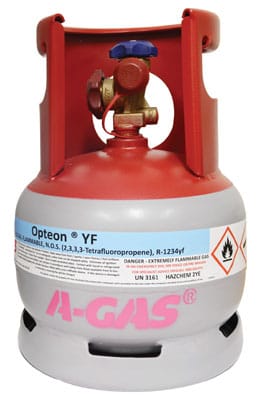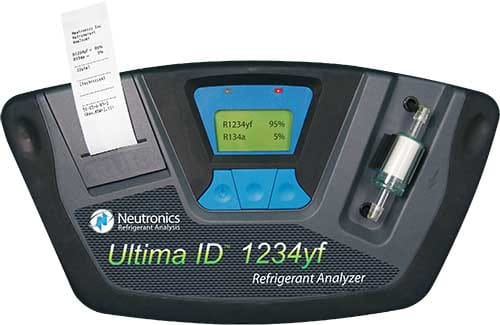Why the change to a new Refrigerant? Where R12 the original Refrigerant used in Automotive applications was shown to be damaging the Ozone layer, R134a which was brought into replace it was found to have a Global Warming Potential. R1234yf has been created to be the new refrigerant in most vehicles that has neither Ozone damaging or Global Warming properties.
Will Vehicles need to be retrofitted? The short answer is No. R134a unlike R12 is not being phased out but rather phased down so over time it will become more expensive but will still be available.
Main characteristics of R1234yf
Low toxicity
Low GWP; GWP = <1
Zero ozone-depleting potential
Class A2L Refrigerant - Mildly flammable
Low total contribution to climate change
Same operating pressures as R134a system
Will your current equipment be suitable – again No.R1234yf is listed as “mildly flammable’ so to stop possible cross contamination for a start the Couplings are different. Reclaim equipment needs to be approved for flammable refrigerant.

A18-4511
Equipment requirements for R1234yf must be A2L Compliant. A R1234yf calibrated gauge set with dedicated R1234yf couplers. As R1234yf is an A2L mildly flammable substance, SAE standards have been developed for hoses and couplings.
Red and blue service hoses, the fittings are 12mm O Ring fittings male with a hexagon nut, (R134a is ½” acme female. R12 - commercial industry standard - is ¼” flare female with a knurled nut).
R1234yf has a unique vehicle quick release fitting, to prevent use of incorrect equipment not fit for this type of refrigerant. Yellow service hose½” LH acme thread (an adaptor is available to fit a universal vacuum pump).

A18-4547
The manifold gauge set is designed to take the male fittings of the hose set and are calibrated to read R1234yf temperatures.

A18-5079
Robinair R1234yf Leak Detector

A18-5119
A18-5119 Single Cylinder Vacuum Pump
Recovery/reclamation equipment (A2L compliant). Although it is not mandatory to recover R1234yf, it is still good environmental practice and, due to the cost of this refrigerant, it would be advisable to do so. Some suppliers can clean recovered refrigerant for re-use.

A18-5119
Dedicated cylinders for recovered or new R1234yf have a left-hand valve thread and require a suitable adaptor to connect to the gauge set charge hose. As R1234yf is a mildly flammable gas, cylinder storage and transport practices will differ to R134a cylinders. Check out the relevant dangerous goods handling and storage requirements for your State or Territory.

A20-8997
A refrigerant identifier is also recommended to ensure you are handling pure R1234yf, free of contaminants such as air or other refrigerants.

Is R1234yf compatible with existing R134a equipment?
No. The R1234yf system refrigerant circuit is accessed using service couplers that are a different size to those of a R134a system.
The service coupler hose connection also has a left-hand thread that requires a matching hose for connection. Hence the need for an R1234yf gauge set.
R1234yf is classified as an A2L mildly flammable refrigerant, and requires the use of equipment designed for use with such a refrigerant.
The exception is an electronic leak detector. Several manufacturers produce detectors that are suited to both refrigerants. Check with your refrigerant wholesaler.
Can I convert an R134a system to R1234yf?
No. R134a systems were not designed to operate using a flammable refrigerant.\
R134a systems should not be converted to use R1234yf as these systems are unable to be converted to a level that satisfies the requirements of international standards (SAE J639 and SAE J2842) set for systems that use R1234yf.
The standards lay down specific requirements for system design. For example, the R1234yf evaporator is significantly stronger than the one you would commonly find in an R134a system.
Aside from the safety aspects, although the two refrigerants have similar thermodynamic properties, they are not the same. Therefore, compressor damage or system performance limitations may be experienced by attempting to convert an R134a system to R1234yf.
Where can I buy R1234yf?
R1234yf is available from Alcius.
Do I need an ARCTick Authorisation and Licence to buy and handle R1234yf?
No. R1234yf is not controlled under Australia’s Ozone Protection and Synthetic Greenhouse Gas legislation. However, a licence is required if it is part of a blend containing a controlled HFC refrigerant. In addition, R134a will still be available, and in older systems, for years to come. It is a legal requirement that automotive workshops who provide air conditioning services (including recovery) continue to hold a refrigerant handling licence and refrigerant trading authorisation if R134a is being used.
For additional licensing requirements, check with your relevant state-based licensing authorities.
Safety issues to be aware of when handling R1234yf
R1234yf is classified as A2L mildly flammable. Technicians need to take the relevant safety measures for the correct transport, storage and handling of a flammable gas. This would include, but is not limited to, ensuring no open flames (including smoking) near the system. It is also worth noting that highly toxic substances are created when this gas is burnt.
Asphyxiation and freeze burns are also a risk. It is advised to check with your state-based Worksafe agency and refer to the relevant material safety data sheets available from your refrigerant wholesalers for specific safeguards when handling this refrigerant. Suitable Personal Protective Equipment (PPE) is to be worn when handling this refrigerant. Suitable trade training in flammable refrigerants is recommended prior to working on systems containing flammable refrigerants.




